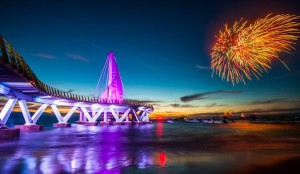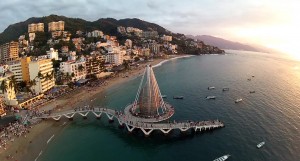History of Los Muertos Beach in Puerto Vallarta

by Prof. Munguia, Fregoso, Carlos
Puerto Vallarta’s official historian
The fine sands of Los Muertos Beach extend from the end of Francisca Rodríguez Street -Hotel Marsol- all the way to the rock formations known as Las Pilitas and El Pulpito. During the last century the beach was used as the embarcation point for the metals produced by the Cuale and San Sebastián mines: “The gold from the mines,in plaques and lingots, was carried over that road, and there, on Los Muertos Beach, awaited the arrival of the ships that would transport it to its destination.”
Las Pilitas is the group of rocks at the end of the beach where the bronze sculpture by Zamarripa, El Caballito, stands. This figure of a small boy riding upon the back of a seahorse, has become one of the symbols of Puerto Vallarta. El Púlpito is a rock promontory, fifty or sixty feet high, that extends into the water and whose sheer face rises straight up out of the foam from the waves continually breaking against its base. According to tradition, don Guadalupe Sánchez Torres, the founder of Puerto Vallarta, sat on the top of El Púlpito and cried when he received the news that the port had been reduced in status from an international port to a coastal trade port on May 10, 1924. Three days later don Guadalupe died at the age of 93.
When the Fierro brothers established an air route between Vallarta and Guadalajara in 1934, their landing strip was a long, flat dirt strip that started at the Landeros’ orchard ( today the Hotel Molino de Agua ) and ended at Los Muertos Beach. One day shortly after beginning operations, one of the planes, ,just after lift-off, plunged into the water a short distance from the beach. Since the water was not very deep where the plane went down, some sailors who were also very good divers, were able to tie ropes to the plane and it was hauled out of the water. Unfortunately, one of the passengers lost his life in the accident. This was the first accident for the Fierro brothers. In 1941, they had another one in which one of the brothers ,Arturo, lost his life.
At the end of World War II, one of the landing craft ,an LST used by the U:S: Navy for landing troops, ran aground at Las Pilitas. There had never been any war manuevers in the bay but every once in a while North American coastal patroll boats would put into the bay just in case there were Japanese submarines in the area. The proximity of the Gulf of California made them nervous because of the possibility of an invasion by way of the gulf.
The landing craft was never removed. There it sat, its landing ramp lowered, at times completely covered by sand, and at others, completely exposed. For many years children played war games on it until time, salt and sand eroded it until not a trace was left.
On the hills east of the beach lived the fishermen who, every morning before sunrise, would come down with sails and oars over their shoulders,to go fishing. One of them, ” El Gaviota”, had a “chirito” – a dug-out canoe – that, for a few pesos,he would rent to the young boys learning to be sailors.
At the foot of the hills there were several “palapas” – palm-frond huts – such as Cloro’s or Murillo’s where coconuts, soft drinks and the occasional glass of “raicillla” were sold. Farther to the south the leafy manzanilla trees provided shade for most bathers but some unfortunate swimmers developed a severe rash from being near the tree.
Los Muertos Beach is the most popular beach in Puerto Vallarta. Up until the 1960’s, it was the favorite place of the families of Vallarta for their Sunday picnics. They would gather in the shade of a palm-frond lean-to and eat the tacos they had brought from home in straw baskets or the tacos that they bought on the beach. adorned with a little shredded cabbage and seasoned liberally with “Tomatlán” sauce.
While the adults, sitting in beach chairs or reclining on woven palm mats, chatted, the children, under the ever-vigilant eyes of their parents, would play in the bay’s crystalline waters. During those years, the only water that ran into the bay was the water from the palapa belonging to Cloro because of the showers that were there. The water came by gravity-flow from Las Canoas (up the River Cuale)and was only used to rinse the salt and sand off the bathers. Instead of the unpleasant odors of gasoline and sun-tan lotion, the beach was fragrant with the smells of salt air breezes and fish-on-a-stick grilling over an open fire.
At the end of the 1950’s when more tourists began to come to Puerto Vallarta, the authorities tried to change the name of the beach. The suggested names were Las Delicias and Playa del Sol but tradition won out and to this day it continues to be Los Muertos Beach. Many people ask about the origen of the name of the beach, a name that, oddly enough, native Vallartans associate with happy childhood memories, not with funeral events.
According to Doña Margarita Mantecón de Garza, the name preceeds the founding of the Las Penas ranch. In her book, The First Centennial of Puerto Vallarta, she states that this was the place where the gold and silver ore was brought from the Cuale Mines by mule drivers to be loaded onto ships. On one occasion, when the ship’s crew was preparing to move the ore from the beach to the waiting ship, they were set upon by a band of Indians who slaughtered the sailors with machetes and left the beach covered with the unburied dead. It was several days later that some mule drivers arrived, found the dead sailors and buried them right there on the beach. Ever since then the beach has been known as Los Muertos Beach.
Another version claims that pirates or smugglers set up an ambush and, when the ore-laden mule drivers appeared, they killed them all and stole the gold they were transporting.
The hypothesis that is probably closest to the truth is the one put forth by several archaeologists such as Dr. Isabel Kelly, who visited the site in 1938, and, more recently, Dr. Joseph Mountjoy. They believe that, originally, the area surrounding Los Muertos Beach was an Indian burial ground and when the first settlers began to build their palapa huts there, they dug up human bones and ceramic shards.
As further confirmation of this theory, in 1960, when the foundations for the Marsol Hotel were being dug, a perfectly polished, green soapstone vase was uncovered. The vase could have been a funeral offering for an important person.
Even Doña Margarita confirms this theory in her book when she mentions that one afternoon Don Guadalupe Sanchez and his brothers went to Los Muertos Beach and “upon arrival they quickly began to excavate and found human remains, idols, and gold (?), but they ran away when they heard noises and whistling sounds coming from the bushes and they thought that it was the Indians that guarded their buried treasures”. Whatever might have been the reason, the beach continues to be called Los Muertos, and even though it has undergone many changes in the last 30 years, it continues to be the favorite.
The hills are no longer covered with palapa huts, they have been replaced by modern hotels and condominiums. Leafy manzanilla trees and wild tabachines no longer grow along the edge of the beach and ones glance no longer glides freely over the sand until it reaches el Púlpito. Now it becomes entangled in the wild profusion of multi-colored beach towels, innumerable palapas and the bikinis covering the bronzed bodies of the tourists. Even though the beach is no longer what it once was, it is still one of the most popular beaches in town.

